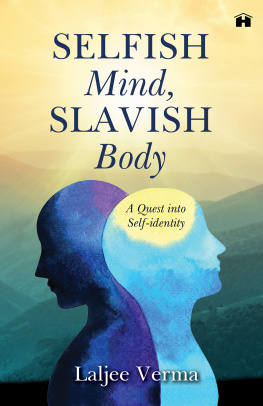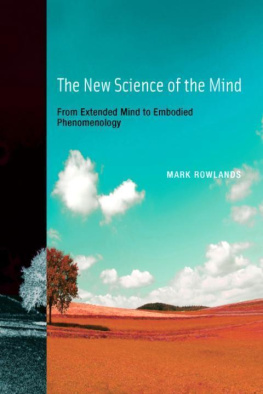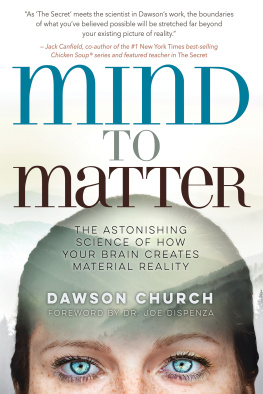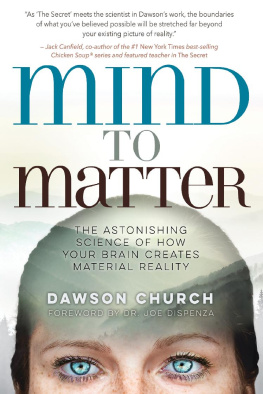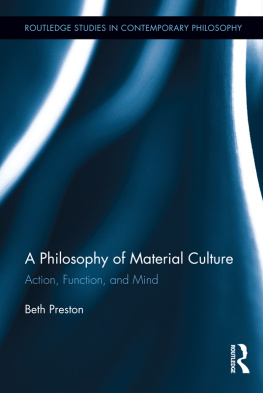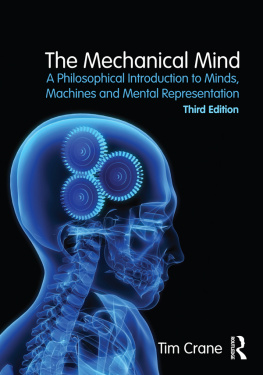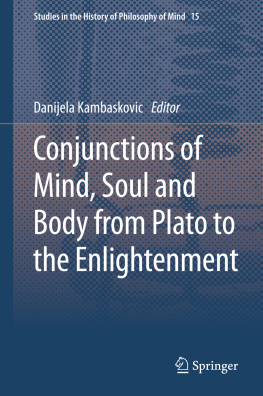
Material and Mind
Material and Mind
Christopher Bardt
The MIT Press
Cambridge, Massachusetts
London, England
2019 Massachusetts Institute of Technology
All rights reserved. No part of this book may be reproduced in any form by any electronic or mechanical means (including photocopying, recording, or information storage and retrieval) without permission in writing from the publisher.
This book was set in Adobe Garamond Pro and Berthold Akzidenz Grotesk by Jen Jackowitz. Printed and bound in the United States of America.
Library of Congress Cataloging-in-Publication Data
Names: Bardt, Christopher, author.
Title: Material and mind / Christopher Bardt.
Description: Cambridge, MA : The MIT Press, [2019] | Includes bibliographical references and index.
Identifiers: LCCN 2018054294 | ISBN 9780262042727 (hardcover : alk. paper)
Subjects: LCSH: Design--Psychological aspects. | Materials.
Classification: LCC NK1520 .B37 2019 | DDC 745.401/9--dc23 LC record available at https://lccn.loc.gov/2018054294
10 9 8 7 6 5 4 3 2 1
ISBN: 978-0-262-04272-7
Retail e-ISBN: 978-0-262-35415-8
Library e-ISBN: 978-0-262-35414-1
MITP e-ISBN: 978-0-262-35413-4
For the B
A good traveler has no fixed plans, and has no intent on arriving.
Lao Tzu
Contents
Concepts and Material
Thought and Action, Action and Thought
Mind and Body
Brain and Hands
Engaging Material
Doubt
Meaning and Emotion
Awareness
Beyond Seeing
Making and Speaking
Social Organization and Art
From Gesture to Thinking
Language and Empathy
The Material Origins of Writing
From Sounds to Marks
Every Story Tells a Picture
Metaphor
Locating the Imagination
Formal and Material Reveries
Visual Images
Eidos and Entelechy
Experience and Conceptualization
Cosmological Concepts and Observations: The Example of Kepler
Science of the Concrete
Theater
Between Recording and Representing
Shadows
Perspective
Conflicts between Perception and Perspective
Drawing and Making
Le Corbusier and Ronchamp
Empathy: Feeling at a Distance
Creativity versus Productivity
Attention
Material Empathy and Material Imagination
Materials and Representation
What the Tugendhat House Tells Us
The Situational Nature of Material
Extended and Enacted Minds
Articulation and Resistance
Cultured Stone and Social Stone
The Bricoleur
Words That Propel
Making and Breaking Rules
Material as a Medium
Material Analogies
Material Thinking
Reductive and Narrative Approaches
Operating between Logos and Mythos
Models
Incremental Creativity
Working Drawings
Scale
Digital Tools
Actions and Commands
Mosaics and Pixels
Ideas and Knowledge
The Digital Hand
From Making to Consuming
Situated and Methodical Thinking
Resistance and Meaning
Digital Fabrication
Flux
Image, Surface, and Screen
Sensible and Sustainable
Digitizations Impact on the Mind
This book has had a long gestation, and many more people have contributed to my thinking and writing than I realized as it was developing. First I want to recognize my parents, who profoundly influenced me even as they carried on with their daily lives. My mother, always engrossed in a book, more often than not a biography of an artist, passed to me her love of the arts, books, and reading. My father, a scientist, a tinkerer by nature, seemingly repurposed everything: he might use a spent brass cartridge to repair broken eyeglasses, gently hammering the tube to magically fit the parts of the arm together. He taught me how to think by making. Such influences are osmotic: they seep in, quietly shaping us, and for that reason I am also grateful to friends and colleagues with whom Ive had enduring relationships.
I wish to acknowledge those who participated directly in fostering this book. After years of gathering notes, which seemed to amount to gathered notes, not much more, I was encouraged by then-RISD President John Maeda to write a book. For that push I am grateful. The ideas of this book slowly grew from years of discussions about architecture, material, and the intersection of reasoning and making and the imagination. I thank my many colleagues from the various disciplines at Rhode Island School of Design for their input and insights over those years. I will single out designers Seth Stem and Robert ONeal, painter Alfred De Credico, and architect Friedrich St.Florian as colleagues, friends, mentors, and deeply sensitive thinkers and makers.
I have also been fortunate to have had wonderful students, some of whose work appears in this book. I wont name them all to avoid leaving anyone out, but I do want to acknowledge their original and vital contributions to the topic of material and mind.
Our practice, 3six0 Architecture, has contributed many of the ideas of the book and demonstrated them in built form. I thank all our staff, especially Jack Ryan, who has been a steady leader, friend, and creative contributor, as well as Matt Osborn and Alice Berresheim.
My first material experiments were done while I was in graduate school studying under John Hejduk, and I am grateful for the freedom he gave me to experiment and fail. Other professors at that timeRobin Evans, Donald Flemming, Paul Rotterdam, and Stephen Jay Gouldhave, to this day, had an outsized impact on the thinking that arose from writing this book. The many long discussions and exchanges with my friend, fellow architect, thinker, and maker Peter Lynch served to underpin much of what this book is about. Friend and poet Stuart Blazer taught me that words are like material; they, too, can resist. Stuart, along with John Duke, Joan Richards, and John Connell, were patient and thoughtful readers of the full manuscript, and I am thankful for their keen insights and suggestions.
A RISD professional development fund grant and additional funding from the RISD Department of Architecture and the Division of Architecture and Design are gratefully acknowledged. Department head Laura Briggs gave early and steadfast encouragement throughout the writing and editing process. Department colleagues Hansy Better and Petra Kempf helped bring the manuscript to the publishing world, and students Chloe Renee Jensen, Margaret Kiladjian, Julie Kress, and Adelaide MacKintosh assisted with drawings, citations, and other prepublication work.
I wish to thank the many generous respondents to my requests for images, especially Barbora Benikov, Daniela Hammer-Tugendhat, Alexandra Timpau, Heli Ojamaa, Denise Schmandt-Besserat, and Linda Pollak.
Executive Editor Robert Prior of the MIT Press was an early and gracious supporter of the manuscript, and has my gratitude for bringing this work to fruition. My editor, Scott Cooper, worked closely with me for the past three years, and I am deeply indebted to him for his guidance, patience, and wonderful ability to bring forth the best of his authors (at least this one). Scott believed in the book, even as a raw manuscript, saw in it something others didnt, and never wavered in his efforts to bring it to press. I am very fortunate to have worked with Scott.
Lastly, my greatest indebtedness is to Kyna Leski, exemplar of a beautiful intelligence, dear friend, life partner, partner in practice, colleague, and wife. As Kyna was writing her remarkable book
Next page

